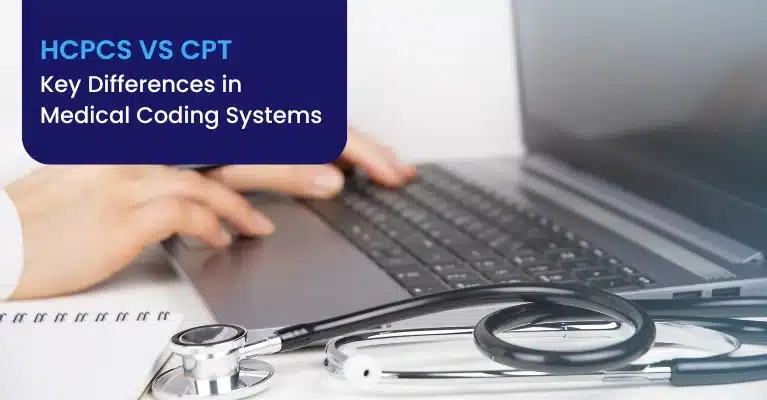
Menu

Medical coding is crucial for effective practice management, accurate billing, and compliance. It allows healthcare facilities to process patient care services and ensures that providers receive appropriate reimbursement.
The core components of medical coding are HCPCS and CPT codes, two critical tools that guide billing processes for various healthcare services and procedures. These coding systems convert complex medical information into standardized codes that insurance providers can easily process, ensuring accuracy and consistency.
To clarify the roles and uses of these codes for healthcare providers this guideline helps to enhance your understanding of these coding systems, improving your billing practices and documentation efficiency.
HCPCS codes are critical to ensure accurate medical equipment and non-physician services billing. They address needs not covered by CPT codes, enhancing compliance and efficiency in medical documentation.
HCPCS was established by the Centers for Medicare & Medicaid Services to standardize healthcare service information across the U.S. It is essential for accurately billing medical supplies and non-physician services.
HCPCS is divided into Level I, equivalent to CPT codes for medical procedures, and Level II, for medical equipment and supplies not covered by CPT.
HCPCS codes facilitate billing for many items like durable medical equipment and specialized services, that are not captured by CPT codes, ensuring comprehensive coverage.
The structure and significance of CPT codes are important for documenting medical, surgical, and diagnostic services in healthcare billing.
CPT codes were developed by the American Medical Association to standardize the reporting of medical services, ensuring consistency and accuracy in healthcare billing.
CPT codes are divided into three categories: Category I for standard medical services, Category II for performance tracking, and Category III for emerging technologies and procedures.
CPT codes are crucial for documenting procedures and services, facilitating accurate billing, and effective communication across medical systems.
Understanding the differences and overlaps between HCPCS and CPT coding systems is essential for accurate healthcare billing and documentation.
| Feature | HCPCS | CPT |
| Definition | Stands for Healthcare Common Procedure Coding System. Used for services, equipment, and non-physician procedures not covered by CPT. | Stands for Current Procedural Terminology. Used by physicians for reporting medical, surgical, and diagnostic services. |
| Purpose | To provide a standardized coding system that includes services, products, and supplies not covered in CPT. | To provide a uniform language for describing medical, surgical, and diagnostic services. |
| Categories | Two levels: Level I (CPT codes) and Level II (services, equipment, and supplies not included in CPT) | Categories: Category I (common procedures), Category II (performance measurement), and Category III (emerging technology). |
| Governing Body | Managed by the Centers for Medicare and Medicaid Services (CMS). | Developed and maintained by the American Medical Association (AMA). |
| Usage | Use for billing Medicare, Medicaid, and other health insurance programs for services and items not covered under CPT. | Use widely across healthcare settings for billing and documentation of procedures and services by physicians. |
| Code Structure | Alphanumeric, consisting of one letter followed by four numbers. | Numeric, consisting of five digits. |
CPT codes vs ICD-10 codes, which detail medical procedures, and ICD-10 codes, which classify diagnoses, highlighting their roles in healthcare documentation and billing.
CPT codes and ICD-10 codes serve unique purposes within the medical field:
Understanding how both coding systems are applied can significantly improve the efficiency and accuracy of medical billing:
Understanding the challenges in using HCPCS and CPT codes is critical in medical health care. This section explains frequent issues, update mechanisms, and best practices for maintaining coding accuracy and compliance.
Explore frequent mistakes in medical coding and strategies to avoid them, enhancing billing accuracy.
Stay informed about annual updates to HCPCS and CPT codes to ensure compliance and accuracy in medical billing.
Implement precise documentation and regular audits to enhance the precision and reliability of medical coding.
In conclusion, understanding HCPCS and CPT codes is important for healthcare professionals. These coding systems support accurate billing and efficient communication within the healthcare community, ensuring that providers receive appropriate reimbursement for services rendered. By staying updated on coding changes and adhering to best practices, medical billers, and coders can reduce errors, enhance compliance, and maintain the financial health of their practices.
HCPCS codes cover broader healthcare services and supplies, while CPT codes are specific to physician-provided services and procedures.
The Centers for Medicare & Medicaid Services (CMS) manage HCPCS codes; the American Medical Association (AMA) maintains CPT codes.
HCPCS and CPT codes are updated annually to incorporate new medical practices and technologies.
No, they cannot due to their distinct applications covering different aspects of medical services and supplies.
Understanding ensures accurate billing, optimizes reimbursement, and maintains compliance with healthcare regulations.



